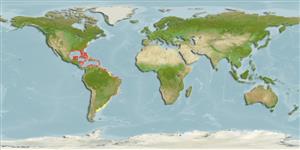Actinopterygii (ray-finned fishes) >
Perciformes (Perch-likes) >
Sparidae (Porgies)
Etymology: Archosargus: Greek, archo = anus + Latin , sargus = sea bream (Ref. 45335).
Environment / Climate / Range
Ecology
Marine; brackish; reef-associated. Subtropical; 22°C - 34°C, preferred 25°C (Ref. 107945); 41°N - 58°S, 98°W - 34°W
Western Atlantic: New Jersey, USA and northeastern Gulf of Mexico to Argentina (Ref. 4517). Absent from the Bahamas (Ref. 26938).
Length at first maturity / Size / Weight / Age
Maturity: Lm 8.0 range ? - ? cm
Max length : 33.0 cm TL male/unsexed; (Ref. 7251); common length : 20.0 cm TL male/unsexed; (Ref. 9626); max. published weight: 550.00 g (Ref. 9626); max. reported age: 2 years (Ref. 3422)
Dorsal
spines
(total): 13;
Dorsal
soft rays
(total): 10-11;
Anal
spines: 3;
Anal
soft rays: 10 - 11. Large intestine makes up 90% of digestive tract and is twice the standard length, on the average; the stomach with 7 digestive caeca attached near the pyloric region. Pelvic fin coloration totally or partially dark in males; orange colored in females. Large dark spot (about same size as eye) below lateral line just behind gill opening (Ref. 26938).
Commonly found over mud bottoms in mangrove sloughs and on vegetated sand bottoms, sometimes in brackish water and occasionally also in coral reef areas near mangroves. Feeds on benthic invertebrates (small bivalves, crustaceans), as well as on plant material.
Robins, C.R. and G.C. Ray, 1986. A field guide to Atlantic coast fishes of North America. Houghton Mifflin Company, Boston, U.S.A. 354 p. (Ref. 7251)
IUCN Red List Status (Ref. 115185)
CITES (Ref. 94142)
Not Evaluated
Threat to humans
Harmless
Human uses
Fisheries: commercial
More information
ReferencesAquacultureAquaculture profileStrainsGeneticsAllele frequenciesHeritabilityDiseasesProcessingMass conversion
Tools
Special reports
Download XML
Internet sources
Estimates of some properties based on models
Phylogenetic diversity index (Ref.
82805): PD
50 = 0.6250 [Uniqueness, from 0.5 = low to 2.0 = high].
Bayesian length-weight: a=0.02291 (0.01860 - 0.02822), b=2.95 (2.89 - 3.01), in cm Total Length, based on LWR estimates for this species (Ref.
93245).
Trophic Level (Ref.
69278): 2.9 ±0.1 se; Based on diet studies.
Resilience (Ref.
69278): High, minimum population doubling time less than 15 months (K=1.27; tm=0.4; tmax=2).
Vulnerability (Ref.
59153): Moderate vulnerability (37 of 100) .
